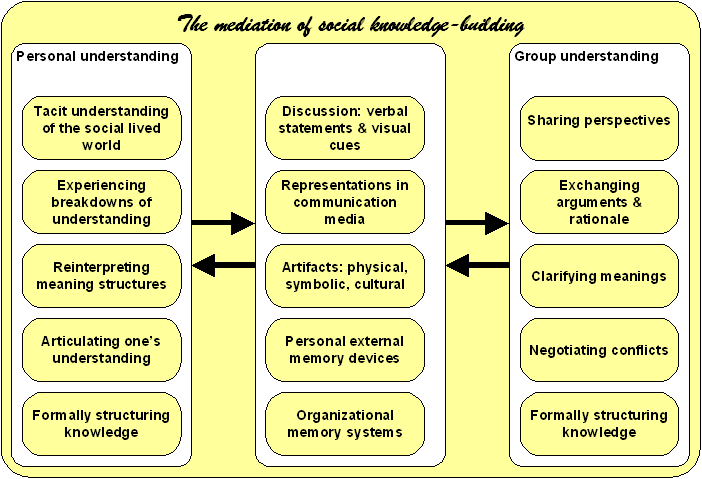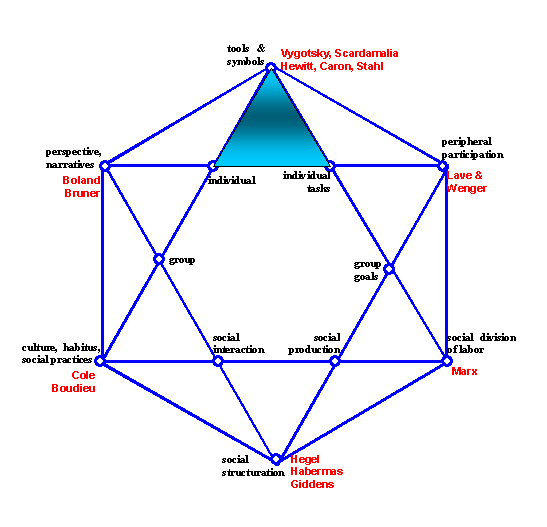

(theses on Vygotsky)
last semester
Perspectives: Boland, Bakhtin
Cognition in context
(large
triangle diagram)
knowledge building in the broader perspective
The phenomenology of mind and its alienation
cognition as social product & product of mediation
Mediated cognition
Principles of a Theory of Mediated Cognition: Theses
from Hegel, Marx & Vygotsky
1.
Human cognition has a material
basis in instinctual animal behavior, but undergoes qualitative
transformations (mediations) which make it essentially and almost entirely
different, although elements of the earlier stages still play a role.
2.
The mediation of human cognition is an historical process that takes place as the cultural history of the
human species (phylogeny) and as the psychological development of the individual
child (ontogeny).
3.
The mediation of individual cognition is a social
process in which:
·
Interpersonal relations are internalized as intrapersonal skills.
·
Relations to objects are mediated by other people.
·
Relations to objects, people and oneself are mediated by cultural
symbols.
·
The world is constructed out of socio-cultural meanings.
·
The mediation of cognition is a form of socialization; the
structure of cultural practices reproduces itself.
·
Mediations are conditioned by their environment of social
structures.
4.
The mediation of cognition takes place externally, "outside the head," through the involvement of
cultural objects, other people and linguistic signs.
5.
In the process of development, numerous mediations build
upon and transform each other. A logic can be seen in how the result of one
mediation forms the prerequisite for another. An individual is always at a
particular stage or zone of development, and is therefore capable of new forms
of mediation building upon that stage.
6.
If an individual is in the presence of someone at a higher developmental
stage (a mentor), then that mentor may be able to guide
the individual through new mediations by example. If no one is at a higher
stage, then a group of people may be able to mediate their collective cognition
through a gradual process of transformative social praxis
through which they create interpersonal relations that can later be
internalized.
7.
Mediated cognition bursts forth in and is preserved (aufgehoben) by
cultural artifacts and linguistic signs that are available interpersonally and
externally, but that require interpretation by active people. We can call these
artifacts "dead labor" and these signs "dead thoughts" –
products of past human activity that preserve their meaning and can be brought
to life under normal social conditions. Culture is the graveyard full of these
monuments to past cognition.
8.
As cognitive mediations, artifact interpretations and symbolic meanings
build up on each other, layer after sedimented layer, their history gets covered
over. The dynamic process of their evolution can then appear as (fetishized)
"second nature." Cognitive capabilities appear as innate faculties;
interpretations appear as natural properties of artifacts; and meanings appear
as definitions of symbols. Social relations that have resulted from countless
negotiations in human history and personal biographies appear as the result of
"human nature" and necessity. Fetishes of cognitive science include:
internal symbolic representations, the human mind, long-term memory, planning,
attention, temporality, self-consciousness, consciousness.
9.
A difficult, highly speculative process of deconstruction
is necessary to retrospectively uncover and piece together the developmental
process that produced the present appearances: the archeology of mediated
cognition.
10.
The mediation of cognition does not end with the modern mind. In fact, having now created a rich basis
of mediations – both cognitive and technological – upon which to grow, the
mediation of the mind races along – generally unnoticed – at a doubly
exponential rate of growth. As lifelong learners, we develop new skills and
literacies in manifold communities and disciplines. If we can analyze and
explicitly understand the mediation process we may be able to guide and support
further development of collaborative cognition with "designer
mediations."
11.
Cognitive scientists have only interpreted the mind; the point (of WebGuide)
is to transform it.
Focal Points of a Theory of Mediated Cognition: From
Readings in Cognitive Science
Hegel :
At the moment when the servant imposes intentional form on
an object of nature in recognition of the master and in fear for himself, the
servant recognizes himself in that external form. Not only does true
self-consciousness first arise in this context of interpersonal recognition of
another and externalization of oneself in an object, but the imposition of
intentional meaning on the object marks the birth of culture embodied in shared
artifacts. Internal self-consciousness and external culture are inseparably and
dialectically bound together from their very first moment on.
Marx :
However, the artifact created by the laborer, as a
commodity made to meet the needs of another, is not the laborer's own. Alienated
from the product in which he hoped to find himself, he is alienated from his
self-consciousness, from nature as the objects of his intentions, and from his
world of cultural meaning. The mediation of consciousness by commodity society
obscures the relations among people producing products to meet the needs of each
other, and this focuses their consciousness instead on the relations among the
commodities as embodiments of value.
Vygotsky:
The human mind is the product of socio-cultural mediations
that essentially transform its capabilities far beyond those that can be
understood in terms of its biological substrate. These mediations can be studied
empirically when understood within the framework of a theory that sees cognition
as the product of this dynamic process involving other people, external objects
and linguistic signs – which then hides itself, internalized in the form of
psychological functions of individual organisms.

![]()
 Return to Gerry Stahl's Home Page.
Return to Gerry Stahl's Home Page. 